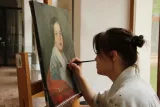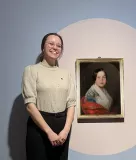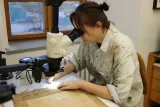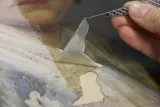Published: 06.12.2024
From a young age, Markéta Svobodová dreamed of becoming a detective or working in a lab. Now a student at the Faculty of Restoration, her childhood aspirations have come to life in an unexpected way. When a long-forgotten, mysterious painting surfaced, Markéta wasn't just tasked with restoring it – she also uncovered the identity and beauty of the young girl immortalised on its canvas.
Initially, Markéta knew very little about the painting. It dated back to the late 19th century, and its artist was unknown. For decades, the piece had languished in the archives of Olomouc, hidden beneath layers of dirt and dust. Humidity and improper storage had taken their toll. "It was in terrible condition," Markéta recounts. "It looks like it had been standing in water for some time, which affected all its components – the decorative frame, the fabric, and the paint layer, which had suffered significant losses." Even the wooden supports bore signs of damage. To make matters worse, the painting had been struck by something heavy, leaving holes and several long cracks. Despite its sorry state, Markéta was captivated from the start. "The girl in the painting is beautiful. Her mysterious gaze immediately drew me in, as if she were trying to tell me something," she shares. Those haunting eyes accompanied her through countless early mornings and long evenings. Little did she know how far this unknown girl would lead her.
When was the last time you saw the painting?
About three days before the end of the exhibition. We created the exhibition to share the painting's story, and I gave guided tours at the museum in Olomouc, walking visitors through our journey together.
Do you miss it?
I did spend a lot of time with it, so in a way, I do. Restoring it was an incredible experience – one I'll never forget. I was fortunate in every way to have had the opportunity to work on it.
How did the painting end up in your hands?
It became the focus of my bachelor's thesis. My supervisor had two paintings lined up for me and a classmate to choose from. We both wanted this one! To be fair, we decided to draw lots (laughs). First, we played rock-paper-scissors to see who would go first – and I won! My classmate ended up with the other painting, and I got my dream project.
Did you know?
The story of the painting was so extraordinary that it inspired an exhibition titled Sister, which was showcased at the Regional Museum in Olomouc. The exhibition was a great success, and there is a possibility it may travel to other venues in the future. It captivated audiences not only with the intricate and meticulous restoration process but also with the almost detective-like journey of uncovering the painting's story. This journey led the student to identify the girl in the painting and piece together the broader context of her family history. "Being part of this incredible process has been a once-in-a-lifetime experience," says Markéta Svobodová, the student behind the restoration. Currently in the second year of her postgraduate studies at the Faculty of Restoration in Litomyšl, Markéta also teaches at a Primary Art School and continues to pursue her own artistic projects.
How did it all begin?
When the painting first came into my hands, it was in a terrible state. I knew the restoration process would be challenging. My first step was to take swabs from the painting for microbiological analysis to check for any infections. There's always a chance that something harmful could be lurking beneath the layers of dirt and dust. Luckily, no mould was detected.
What came next?
Next was a detailed photographic documentation process, an essential part of any restoration research. It helps us uncover important details about the artwork. Using imaging techniques, I photographed the painting under various types of light: daylight, ultraviolet, and infrared. The final step involved an X-ray examination.
What did the survey reveal?
The non-invasive analysis provided valuable insights into the painting's materials and structure. For example, it showed that the artist used pigments with metallic compounds. When pigments contain heavy metal-based substances, they create a strong glow under X-rays. Seeing the whites light up so vividly, I immediately recognised the use of lead white. In addition to this, invasive methods were used, such as taking microscopic samples from the painting. These samples revealed more about the binders, pigments, and the intricate layers that make up the artwork.
Why is all this necessary?
To gather as much information as possible about the painting. This knowledge allowed me to create a comprehensive restoration plan. From a research perspective, the painting was incredibly fascinating, offering many unique insights into its creation and history.
Were you surprised by anything revealed in the survey?
The biggest surprise came when I used ultraviolet light. Suddenly, text appeared on the reverse side of the painting. It was faintly visible in daylight but completely illegible. After some graphic adjustments, the text became clear – and there it was, written in German.
What did it say?
"Pauline Keszler, born in Loštice in Moravia, sister of the painter of historical paintings Jos. Keszler in Vienna, painted in Loštice 1850..."
That must have been a significant clue!
It was huge! I was running around the faculty, telling everyone with so much excitement (laughs). This discovery prompted me to delve deeper into Josef Kessler, the painter mentioned in the text. I scoured various sources, but there wasn't much information about him in the literature. Then, I stumbled upon a book specifically about him. It was written by an Austrian priest, Hans Klinger, who was a devoted admirer of Kessler's work.
Where did the book lead you?
The book detailed Josef Kessler's life and mentioned that he had five brothers. But the painting clearly depicted a woman. What puzzled me was that there was no mention of a sister anywhere in the book. This made me question if the translation of the text was wrong.
Was it?
No, the translation was correct. But the lack of any reference to a sister didn't make sense, so I turned to 19th-century records from Loštice, where Josef Kessler was born. I started combing through the registers to see if a daughter had been born into his family. It was tough – the records were handwritten in German cursive, and I was exhausted. The lines blurred together as I read them over and over. All I kept finding were mentions of his brothers. And then, suddenly, there it was. I can still picture it (laughs).
You found the missing sister!
Yes! It was 2:37 in the morning when I saw Pauline Kessler's name in the register. At first, I thought I was dreaming. I was so tired I closed the book, but when I looked again in the morning, it was still there (laughs).
How did it feel?
I was both thrilled and stunned. It was a monumental moment – not just for the painting but also for the historical record. I had disproved a detail in the book and uncovered the existence of a sister who had been completely overlooked. It was incredible to think that Pauline Kessler had finally been found after all these years.
Didn't the restoration take a backseat because of your search for the painter's history?
I couldn't afford for that to happen! Restoring the painting was the subject of my bachelor's thesis, and I had to complete both the restoration and the research on time (laughs). The additional research came later.
What did you enjoy most about restoring the painting?
From the very beginning, I aimed to restore the painting as a whole, which included the decorative gilded frame. That wasn't a typical part of my bachelor's studies, so it was both a challenge and a chance to learn new techniques. Once I cleaned off the thickest layers of dust and dirt, I removed the painting from the decorative frame and stretcher to access the underlying layers. That's when I discovered that the central scene had been painted on paper, surrounded by and backed with fabric. The entire piece was supported by an additional layer of fabric on the reverse.
What restoration procedures did you perform?
I focused on preserving as many original fragments as possible, adjusting my approach accordingly. First, I worked to even out the surface and straighten the edges. I reinforced the paper backing with Japanese paper to mend the holes and cracks. Once the general repairs were complete, I added a new canvas backing to stabilise the entire piece. Next, I turned to the colour layer. I tested the solubility of the old varnish and began thinning it. As I worked, the original colours started to emerge – vivid and breathtaking. Over time, varnish yellows and darkens, so removing it brought the painting back to life. The colours were stunning Finally, I used a blending imitative retouch technique to restore the areas where paint was missing, seamlessly integrating them with the rest of the artwork. Once everything was complete, I reassembled the painting, including its gilded frame. Seeing it restored to its full beauty was incredibly rewarding.
What is particularly important when restoring such a work?
The key is to restore it without causing any harm to the original. Every intervention I made had to be both aesthetically acceptable and as reversible as possible. This means that if someone in the future decides my work isn't suitable, they should be able to undo it without damaging the original painting.
When did you realise the painting might be included in an exhibition?
During the restoration process, as I uncovered more about the identity of the girl in the painting, it became clear that the work could serve as the centrepiece of an exhibition. This added an extra layer of responsibility to the restoration. While I could have taken a purely conservative approach, the potential for an exhibition made it crucial to also restore the painting's aesthetic value. It was an amazing opportunity to undertake a more comprehensive restoration that could be shared with the public.
Did you eventually uncover the entire history of the painting?
When I identified the girl in the painting, Michaela Čadilová, the exhibition's curator, became deeply interested in the research. She was just as enthusiastic as I was, and we began working together to trace the painting's history. We were eager to see how far back we could go.
What did you discover?
We learned that the painter, Josef Kessler, didn't have children, but his brothers did. By following their lineage, we found two branches of the family who owned other paintings by him – artworks we were keen to see.
Did you meet with them?
Yes, we visited one family in Loštice. They shared a wealth of valuable information and were incredibly helpful. It turns out they were the same family Hans Klinger had visited when researching for his publication on Kessler.
Did the other family contribute to the puzzle as well?
They had a painting we were particularly interested in. Klinger's book included a black-and-white photograph of a painting of a girl, and based on the features, we suspected it could be "our" Pauline – just older.
Was your suspicion confirmed?
When we saw the painting in person, the resemblance was undeniable. The girl in the second painting looked strikingly similar to "our" Pauline. Upon closer inspection, we found Josef Kessler's signature on the painting, along with the year 1860 – exactly ten years after the first painting. I later superimposed photographs of both paintings on the computer. By cross-referencing their features, we confirmed that "our" Pauline Kessler is indeed the subject of both works. The shared, unmistakable characteristics left no doubt.
The family had no idea who was in the picture?
They called the painting Auntie Bušinka, believing it depicted the painter's aunt, Libuše. This name had been passed down through the family. Unlike "our" painting, this one was more intimate. The painter's style seemed looser and more graceful, evident in the expression, clothing, and overall composition. In contrast, "our" painting appeared to have a more representative or formal function.
But you knew right away that the other painting was of Pauline, too...
During our visit to the first family, we were shown a photograph of a woman they called Auntie Zhánělová. By then, we knew Pauline had married František Zháněl at around 38 years old and taken the surname Zhánělová. Suddenly, we had three versions of Pauline Kessler before us at different stages of her life. That's when the whole puzzle came together.
And that's when it became clear there would be an exhibition.
It's unusual to create an exhibition centred on a single painting, but this case was special. First, people were impressed by my restoration work, and second, the painting's story was so captivating. It's rare to uncover such a significant piece of history through restoration. Together with the museum curator, we began planning an exhibition aptly titled Sister.
How did you feel while working on the painting?
It felt like solving a detective story (laughs). Bit by bit, piece by piece, I pieced everything together, and then it all clicked. It's still incredible to me that, through my dedication and discoveries, we were able to uncover so much.
Detectives often keep little notebooks. Where did you record all the information you found?
I kept a journal to ensure all my notes were in one place. At the same time, I maintained restoration documentation from the very beginning. That's a standard part of the process, and all the key details had to go there. When I didn't have paper handy, I'd jot down quick notes on my hand (laughs).
You speak about your work with such enthusiasm – it's clear you've chosen the right field.
I really love restoration. What fascinates me is how it combines so many disciplines. You need to approach a piece holistically, understanding what's best for it. I always say you need to be a little bit schizophrenic in this field – you're part photographer, technologist, chemist, art historian, artist, and skilled craftsman. And that's what makes it endlessly rewarding for me.
TEXT Zuzana Paulusová: PHOTO Archiv Markéta Svobodová







